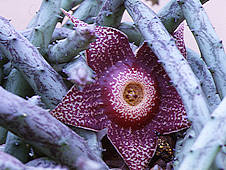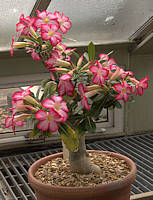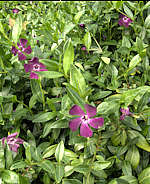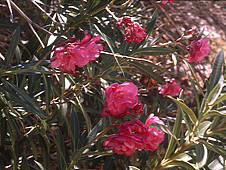Apocynaceae Jussieu 1789
The Apocynaceae includes a large group of around 2000 species of tropical and subtropical trees, shrubs, herbs and vines. The Family includes many well-known ornamental shrubs and vines (Oleander, Frangipani, Allamanda, Mandevilla, Vinca), the Subfamily Asclepiadaceae many of which are stem succulents, and the succulent genera Adenium, Pachypodium, and Plumeria, some of which are also of horticultural interest.
Plants in the Apocynaceae usually have simple, opposite leaves, but they may be alternate or whorled. Some are stem succulents with fleshy succulent leaves, vestigal leaves or no leaves.
In many cases the sap is milky and may contain toxic alkaloids or glycosides. Some of these compounds are used in conventional or traditional medicine e.g. quinine, vincristine, cardiac glycosides. Asclepias tuberosum is a traditional treatment for pleurisy. The latex from the sap of a few species has been used as a source of rubber. The watery latex of Pachypodium lealii is used as arrow poison by bushmen. Oleander is so poisonous that eating a single leaf may kill an adult.
Flowers are bisexual. Their calyx and corolla are usually five-lobed with distinct stamens and anthers facing inwards and often adherent to the surface of the stigma. In some species the pollen is agglutinated into paired masses called pollinia, which are transferred intact during pollination.
Fruits and seed pods are usually produced in pairs, with seeds that are flat and winged or have a tuft of hairs at one end.


 |




 Families of Succulent Plants
Families of Succulent Plants 





